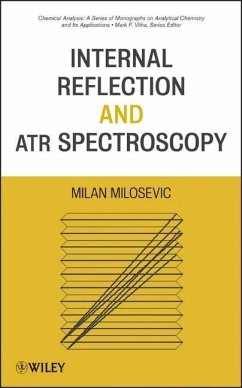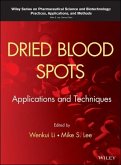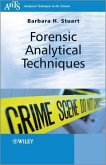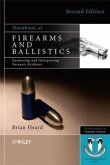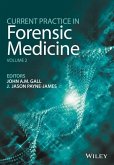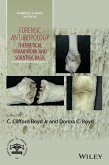Milan Milosevic
Internal Reflection and Atr Spectroscopy
Milan Milosevic
Internal Reflection and Atr Spectroscopy
- Gebundenes Buch
- Merkliste
- Auf die Merkliste
- Bewerten Bewerten
- Teilen
- Produkt teilen
- Produkterinnerung
- Produkterinnerung
Attenuated Total Reflection (ATR) Spectroscopy is now the most frequently used sampling technique for infrared spectroscopy. This book fully explains the theory and practice of this method. Offers introduction and history of ATR before discussing theoretical aspects Includes informative illustrations and theoretical calculations Discusses many advanced aspects of ATR, such as depth profiling or orientation studies, and particular features of reflectance
Andere Kunden interessierten sich auch für
![Dried Blood Spots Dried Blood Spots]() Dried Blood Spots159,99 €
Dried Blood Spots159,99 €![Forensic Analytical Techniques Forensic Analytical Techniques]() Barbara B. StuartForensic Analytical Techniques192,99 €
Barbara B. StuartForensic Analytical Techniques192,99 €![Handbook of Firearms and Ballistics Handbook of Firearms and Ballistics]() Brian J. HeardHandbook of Firearms and Ballistics145,99 €
Brian J. HeardHandbook of Firearms and Ballistics145,99 €![Forensic Science Education and Training Forensic Science Education and Training]() Forensic Science Education and Training117,99 €
Forensic Science Education and Training117,99 €![Current Practice in Forensic Medicine, Volume 2 Current Practice in Forensic Medicine, Volume 2]() Current Practice in Forensic Medicine, Volume 2133,99 €
Current Practice in Forensic Medicine, Volume 2133,99 €![Forensic Science and Humanitarian Action, 2 Volume Set Forensic Science and Humanitarian Action, 2 Volume Set]() Forensic Science and Humanitarian Action, 2 Volume Set259,99 €
Forensic Science and Humanitarian Action, 2 Volume Set259,99 €![Forensic Anthropology Forensic Anthropology]() Forensic Anthropology168,99 €
Forensic Anthropology168,99 €-
-
-
Attenuated Total Reflection (ATR) Spectroscopy is now the most frequently used sampling technique for infrared spectroscopy. This book fully explains the theory and practice of this method. Offers introduction and history of ATR before discussing theoretical aspects Includes informative illustrations and theoretical calculations Discusses many advanced aspects of ATR, such as depth profiling or orientation studies, and particular features of reflectance
Hinweis: Dieser Artikel kann nur an eine deutsche Lieferadresse ausgeliefert werden.
Hinweis: Dieser Artikel kann nur an eine deutsche Lieferadresse ausgeliefert werden.
Produktdetails
- Produktdetails
- Chemical Analysis: A Series of Monographs on Analytical Chemistry and Its Applications .
- Verlag: Wiley & Sons
- 1. Auflage
- Seitenzahl: 264
- Erscheinungstermin: 5. Juni 2012
- Englisch
- Abmessung: 244mm x 161mm x 22mm
- Gewicht: 490g
- ISBN-13: 9780470278321
- ISBN-10: 0470278323
- Artikelnr.: 35056819
- Herstellerkennzeichnung
- Libri GmbH
- Europaallee 1
- 36244 Bad Hersfeld
- gpsr@libri.de
- Chemical Analysis: A Series of Monographs on Analytical Chemistry and Its Applications .
- Verlag: Wiley & Sons
- 1. Auflage
- Seitenzahl: 264
- Erscheinungstermin: 5. Juni 2012
- Englisch
- Abmessung: 244mm x 161mm x 22mm
- Gewicht: 490g
- ISBN-13: 9780470278321
- ISBN-10: 0470278323
- Artikelnr.: 35056819
- Herstellerkennzeichnung
- Libri GmbH
- Europaallee 1
- 36244 Bad Hersfeld
- gpsr@libri.de
MILAN MILOSEVIC works as a consultant in the field of optical spectroscopy for MeV Technologies, LLC. Milan has spent his entire career in the field of FTIR spectroscopy, developing spectroscopic equipment and building our understanding of the physical basis of spectroscopy. He has pioneered several devices for what have become standard spectroscopic techniques, including micro ATR, variable angle ATR, and grazing angle ATR spectroscopy. Holding over fifteen US patents, Milan has authored or coauthored over thirty peer-reviewed papers on various aspects of spectroscopy.
Preface xiii
1 Introduction to Spectroscopy 1
1.1 History 1
1.2 Definition of Transmittance and Reflectance 6
1.3 The Spectroscopic Experiment and the Spectrometer 10
1.4 Propagation of Light through a Medium 13
1.5 Transmittance and Absorbance 15
1.6 S/N in a Spectroscopic Measurement 16
2 Harmonic Oscillator Model for Optical Constants 20
2.1 Harmonic Oscillator Model for Polarizability 20
2.2 Clausius-Mossotti Equation 25
2.3 Refractive Index 26
2.4 Absorption Index and Concentration 29
3 Propagation of Electromagnetic Energy 31
3.1 Poynting Vector and Flow of Electromagnetic Energy 31
3.2 Linear Momentum of Light 34
3.3 Light Absorption in Absorbing Media 35
3.4 Lambert Law and Molecular Cross Section 36
4 Fresnel Equations 39
4.1 Electromagnetic Fields at the Interface 39
4.2 Snell's Law 41
4.3 Boundary Conditions at the Interface 42
4.4 Fresnel Formulae 43
4.5 Refl ectance and Transmitance of Interface 44
4.6 Snell's Pairs 46
4.7 Normal Incidence 47
4.8 Brewster's Angle 47
4.9 The Case of the 45° Angle of Incidence 48
4.10 Total Internal Reflection 49
5 Evanescent Wave 55
5.1 Exponential Decay and Penetration Depth 55
5.2 Energy Flow at a Totally Internally Reflecting Interface 58
5.3 The Evanescent Wave in Absorbing Materials 59
6 Electric Fields at a Totally Internally Reflecting Interface 61
6.1 Ex, Ey, and Ez for s-Polarized Incident Light 61
6.2 Ex, Ey, and Ez for p-Polarized Incident Light 62
7 Anatomy of ATR Absorption 67
7.1 Attenuated Total Reflection (ATR) Reflectance for s- and p-Polarized
Beam 67
7.2 Absorbance Transform of ATR Spectra 69
7.3 Weak Absorption Approximation 70
7.4 Supercritical Reflectance and Absorption of Evanescent Wave 73
7.5 The Leaky Interface Model 76
8 Effective Thickness 79
8.1 Defi nition and Expressions for Effective Thickness 79
8.2 Effective Thickness and Penetration Depth 80
8.3 Effective Thickness and ATR Spectroscopy 82
8.4 Effective Thickness for Strong Absorptions 84
9 Internal Reflectance near Critical Angle 85
9.1 Transition from Subcritical to Supercritical Reflection 85
9.2 Effective Thickness and Refractive Index of Sample 87
9.3 Critical Angle and Refractive Index of Sample 88
10 Depth Profiling 92
10.1 Energy Absorption at Different Depths 92
10.2 Thin Absorbing Layer on a Nonabsorbing Substrate 93
10.3 Thin Nonabsorbing Film on an Absorbing Substrate 94
10.4 Thin Nonabsorbing Film on a Thin Absorbing Film on a Nonabsorbing
Substrate 94
11 Multiple Interfaces 97
11.1 Reflectance and Transmittance of a Two-Interface System 97
11.2 Very Thin Films 100
11.3 Interference Fringes 101
11.4 Normal Incidence 102
11.5 Interference Fringes and Transmission Spectroscopy 104
11.6 Thin Films and ATR 108
11.7 Internal Reflection: Subcritical, Supercritical, and in between 109
11.8 Unusual Fringes 110
11.9 Penetration Depth Revisited 113
11.10 Reflectance and Transmittance of a Multiple Interface System 116
12 Metal Optics 121
12.1 Electromagnetic Fields in Metals 121
12.2 Plasma 126
12.3 Reflectance of Metal Surfaces 127
12.4 Thin Metal Films on Transparent Substrates 130
12.5 Curious Reflectance of Extremely Thin Metal Films 132
12.6 ATR Spectroscopy through Thin Metal Films 134
13 Grazing Angle ATR (GAATR) Spectroscopy 136
13.1 Attenuated Total Refl ection (ATR) Spectroscopy of Thin Films on
Silicon Substrates 136
13.2 Enhancement for s- and p-Polarized Light 137
13.3 Enhancement and Film Thickness 139
13.4 Electric Fields in a Very Thin Film on a Si Substrate 141
13.5 Source of Enhancement 143
13.6 GAATR Spectroscopy 145
14 Super Grazing Angle Reflection Spectroscopy (SuGARS) 147
14.1 Reflectance of Thin Films on Metal Substrates 147
14.2 Problem of Reference 148
14.3 Sensitivity Enhancement 150
15 ATR Experiment 151
15.1 Multiple Reflection Attenuated Total Reflection (ATR) 151
15.2 Facet Reflections 155
15.3 Beam Spread and the Angle of Incidence 156
15.4 Effect of Facet Shape 158
15.5 Beam Spread and the Number of Reflections in Multiple Refl ection ATR
160
15.6 Effect of Beam Alignment on Multiple Reflection ATR 162
15.7 Change in the Refractive Index of the Sample due to Concentration
Change 166
16 ATR Spectroscopy of Small Samples 168
16.1 Benefits of Attenuated Total Reflection (ATR) for Microsampling 168
16.2 Contact Problem for Solid Samples 170
17 Surface Plasma Waves 172
17.1 Excitation of Surface Plasma Waves 172
17.2 Effect of Metal Film Thickness on Reflectance 173
17.3 Effect of the Refractive Index of Metal on Reflectance 174
17.4 Effect of the Absorption Index of Metal on Reflectance 174
17.5 Use of Plasmons for Detecting Minute Changes of the Refractive Index
of Materials 175
17.6 Use of Plasmons for Detecting Minute Changes of the Absorption Index
of Materials 178
18 Extraction of Optical Constants of Materials from Experiments 180
18.1 Extraction of Optical Constants from Multiple Experiments 180
18.2 Kramers-Kronig Relations 184
18.3 Kramers-Kronig Equations for Normal Incidence Reflectance 187
19 ATR Spectroscopy of Powders 192
19.1 Propagation of Light through Inhomogeneous Media 192
19.2 Spectroscopic Analysis of Powdered Samples 193
19.3 Particle Size and Absorbance of Powders 195
19.4 Propagation of Evanescent Wave in Powdered Media 198
20 Energy Flow at a Totally Internally Reflecting Interface 209
20.1 Energy Conservation at a Totally Reflecting Interface 209
20.2 Speed of Propagation and the Formation of an Evanescent Wave 212
21 Orientation Studies and ATR Spectroscopy 214
21.1 Oriented Fraction and Dichroic Ratio 214
21.2 Orientation and Field Strengths in Attenuated Total Reflection (ATR)
217
22 Applications of ATR Spectroscopy 220
22.1 Solid Samples 220
22.2 Liquid Samples 220
22.3 Powders 221
22.4 Surface-Modified Solid Samples 221
22.5 High Sample Throughput ATR Analysis 221
22.6 Process and Reaction Monitoring 222
Appendix A ATR Correction 224
Appendix B Quantification in ATR Spectroscopy 227
Index 237
1 Introduction to Spectroscopy 1
1.1 History 1
1.2 Definition of Transmittance and Reflectance 6
1.3 The Spectroscopic Experiment and the Spectrometer 10
1.4 Propagation of Light through a Medium 13
1.5 Transmittance and Absorbance 15
1.6 S/N in a Spectroscopic Measurement 16
2 Harmonic Oscillator Model for Optical Constants 20
2.1 Harmonic Oscillator Model for Polarizability 20
2.2 Clausius-Mossotti Equation 25
2.3 Refractive Index 26
2.4 Absorption Index and Concentration 29
3 Propagation of Electromagnetic Energy 31
3.1 Poynting Vector and Flow of Electromagnetic Energy 31
3.2 Linear Momentum of Light 34
3.3 Light Absorption in Absorbing Media 35
3.4 Lambert Law and Molecular Cross Section 36
4 Fresnel Equations 39
4.1 Electromagnetic Fields at the Interface 39
4.2 Snell's Law 41
4.3 Boundary Conditions at the Interface 42
4.4 Fresnel Formulae 43
4.5 Refl ectance and Transmitance of Interface 44
4.6 Snell's Pairs 46
4.7 Normal Incidence 47
4.8 Brewster's Angle 47
4.9 The Case of the 45° Angle of Incidence 48
4.10 Total Internal Reflection 49
5 Evanescent Wave 55
5.1 Exponential Decay and Penetration Depth 55
5.2 Energy Flow at a Totally Internally Reflecting Interface 58
5.3 The Evanescent Wave in Absorbing Materials 59
6 Electric Fields at a Totally Internally Reflecting Interface 61
6.1 Ex, Ey, and Ez for s-Polarized Incident Light 61
6.2 Ex, Ey, and Ez for p-Polarized Incident Light 62
7 Anatomy of ATR Absorption 67
7.1 Attenuated Total Reflection (ATR) Reflectance for s- and p-Polarized
Beam 67
7.2 Absorbance Transform of ATR Spectra 69
7.3 Weak Absorption Approximation 70
7.4 Supercritical Reflectance and Absorption of Evanescent Wave 73
7.5 The Leaky Interface Model 76
8 Effective Thickness 79
8.1 Defi nition and Expressions for Effective Thickness 79
8.2 Effective Thickness and Penetration Depth 80
8.3 Effective Thickness and ATR Spectroscopy 82
8.4 Effective Thickness for Strong Absorptions 84
9 Internal Reflectance near Critical Angle 85
9.1 Transition from Subcritical to Supercritical Reflection 85
9.2 Effective Thickness and Refractive Index of Sample 87
9.3 Critical Angle and Refractive Index of Sample 88
10 Depth Profiling 92
10.1 Energy Absorption at Different Depths 92
10.2 Thin Absorbing Layer on a Nonabsorbing Substrate 93
10.3 Thin Nonabsorbing Film on an Absorbing Substrate 94
10.4 Thin Nonabsorbing Film on a Thin Absorbing Film on a Nonabsorbing
Substrate 94
11 Multiple Interfaces 97
11.1 Reflectance and Transmittance of a Two-Interface System 97
11.2 Very Thin Films 100
11.3 Interference Fringes 101
11.4 Normal Incidence 102
11.5 Interference Fringes and Transmission Spectroscopy 104
11.6 Thin Films and ATR 108
11.7 Internal Reflection: Subcritical, Supercritical, and in between 109
11.8 Unusual Fringes 110
11.9 Penetration Depth Revisited 113
11.10 Reflectance and Transmittance of a Multiple Interface System 116
12 Metal Optics 121
12.1 Electromagnetic Fields in Metals 121
12.2 Plasma 126
12.3 Reflectance of Metal Surfaces 127
12.4 Thin Metal Films on Transparent Substrates 130
12.5 Curious Reflectance of Extremely Thin Metal Films 132
12.6 ATR Spectroscopy through Thin Metal Films 134
13 Grazing Angle ATR (GAATR) Spectroscopy 136
13.1 Attenuated Total Refl ection (ATR) Spectroscopy of Thin Films on
Silicon Substrates 136
13.2 Enhancement for s- and p-Polarized Light 137
13.3 Enhancement and Film Thickness 139
13.4 Electric Fields in a Very Thin Film on a Si Substrate 141
13.5 Source of Enhancement 143
13.6 GAATR Spectroscopy 145
14 Super Grazing Angle Reflection Spectroscopy (SuGARS) 147
14.1 Reflectance of Thin Films on Metal Substrates 147
14.2 Problem of Reference 148
14.3 Sensitivity Enhancement 150
15 ATR Experiment 151
15.1 Multiple Reflection Attenuated Total Reflection (ATR) 151
15.2 Facet Reflections 155
15.3 Beam Spread and the Angle of Incidence 156
15.4 Effect of Facet Shape 158
15.5 Beam Spread and the Number of Reflections in Multiple Refl ection ATR
160
15.6 Effect of Beam Alignment on Multiple Reflection ATR 162
15.7 Change in the Refractive Index of the Sample due to Concentration
Change 166
16 ATR Spectroscopy of Small Samples 168
16.1 Benefits of Attenuated Total Reflection (ATR) for Microsampling 168
16.2 Contact Problem for Solid Samples 170
17 Surface Plasma Waves 172
17.1 Excitation of Surface Plasma Waves 172
17.2 Effect of Metal Film Thickness on Reflectance 173
17.3 Effect of the Refractive Index of Metal on Reflectance 174
17.4 Effect of the Absorption Index of Metal on Reflectance 174
17.5 Use of Plasmons for Detecting Minute Changes of the Refractive Index
of Materials 175
17.6 Use of Plasmons for Detecting Minute Changes of the Absorption Index
of Materials 178
18 Extraction of Optical Constants of Materials from Experiments 180
18.1 Extraction of Optical Constants from Multiple Experiments 180
18.2 Kramers-Kronig Relations 184
18.3 Kramers-Kronig Equations for Normal Incidence Reflectance 187
19 ATR Spectroscopy of Powders 192
19.1 Propagation of Light through Inhomogeneous Media 192
19.2 Spectroscopic Analysis of Powdered Samples 193
19.3 Particle Size and Absorbance of Powders 195
19.4 Propagation of Evanescent Wave in Powdered Media 198
20 Energy Flow at a Totally Internally Reflecting Interface 209
20.1 Energy Conservation at a Totally Reflecting Interface 209
20.2 Speed of Propagation and the Formation of an Evanescent Wave 212
21 Orientation Studies and ATR Spectroscopy 214
21.1 Oriented Fraction and Dichroic Ratio 214
21.2 Orientation and Field Strengths in Attenuated Total Reflection (ATR)
217
22 Applications of ATR Spectroscopy 220
22.1 Solid Samples 220
22.2 Liquid Samples 220
22.3 Powders 221
22.4 Surface-Modified Solid Samples 221
22.5 High Sample Throughput ATR Analysis 221
22.6 Process and Reaction Monitoring 222
Appendix A ATR Correction 224
Appendix B Quantification in ATR Spectroscopy 227
Index 237
Preface xiii
1 Introduction to Spectroscopy 1
1.1 History 1
1.2 Definition of Transmittance and Reflectance 6
1.3 The Spectroscopic Experiment and the Spectrometer 10
1.4 Propagation of Light through a Medium 13
1.5 Transmittance and Absorbance 15
1.6 S/N in a Spectroscopic Measurement 16
2 Harmonic Oscillator Model for Optical Constants 20
2.1 Harmonic Oscillator Model for Polarizability 20
2.2 Clausius-Mossotti Equation 25
2.3 Refractive Index 26
2.4 Absorption Index and Concentration 29
3 Propagation of Electromagnetic Energy 31
3.1 Poynting Vector and Flow of Electromagnetic Energy 31
3.2 Linear Momentum of Light 34
3.3 Light Absorption in Absorbing Media 35
3.4 Lambert Law and Molecular Cross Section 36
4 Fresnel Equations 39
4.1 Electromagnetic Fields at the Interface 39
4.2 Snell's Law 41
4.3 Boundary Conditions at the Interface 42
4.4 Fresnel Formulae 43
4.5 Refl ectance and Transmitance of Interface 44
4.6 Snell's Pairs 46
4.7 Normal Incidence 47
4.8 Brewster's Angle 47
4.9 The Case of the 45° Angle of Incidence 48
4.10 Total Internal Reflection 49
5 Evanescent Wave 55
5.1 Exponential Decay and Penetration Depth 55
5.2 Energy Flow at a Totally Internally Reflecting Interface 58
5.3 The Evanescent Wave in Absorbing Materials 59
6 Electric Fields at a Totally Internally Reflecting Interface 61
6.1 Ex, Ey, and Ez for s-Polarized Incident Light 61
6.2 Ex, Ey, and Ez for p-Polarized Incident Light 62
7 Anatomy of ATR Absorption 67
7.1 Attenuated Total Reflection (ATR) Reflectance for s- and p-Polarized
Beam 67
7.2 Absorbance Transform of ATR Spectra 69
7.3 Weak Absorption Approximation 70
7.4 Supercritical Reflectance and Absorption of Evanescent Wave 73
7.5 The Leaky Interface Model 76
8 Effective Thickness 79
8.1 Defi nition and Expressions for Effective Thickness 79
8.2 Effective Thickness and Penetration Depth 80
8.3 Effective Thickness and ATR Spectroscopy 82
8.4 Effective Thickness for Strong Absorptions 84
9 Internal Reflectance near Critical Angle 85
9.1 Transition from Subcritical to Supercritical Reflection 85
9.2 Effective Thickness and Refractive Index of Sample 87
9.3 Critical Angle and Refractive Index of Sample 88
10 Depth Profiling 92
10.1 Energy Absorption at Different Depths 92
10.2 Thin Absorbing Layer on a Nonabsorbing Substrate 93
10.3 Thin Nonabsorbing Film on an Absorbing Substrate 94
10.4 Thin Nonabsorbing Film on a Thin Absorbing Film on a Nonabsorbing
Substrate 94
11 Multiple Interfaces 97
11.1 Reflectance and Transmittance of a Two-Interface System 97
11.2 Very Thin Films 100
11.3 Interference Fringes 101
11.4 Normal Incidence 102
11.5 Interference Fringes and Transmission Spectroscopy 104
11.6 Thin Films and ATR 108
11.7 Internal Reflection: Subcritical, Supercritical, and in between 109
11.8 Unusual Fringes 110
11.9 Penetration Depth Revisited 113
11.10 Reflectance and Transmittance of a Multiple Interface System 116
12 Metal Optics 121
12.1 Electromagnetic Fields in Metals 121
12.2 Plasma 126
12.3 Reflectance of Metal Surfaces 127
12.4 Thin Metal Films on Transparent Substrates 130
12.5 Curious Reflectance of Extremely Thin Metal Films 132
12.6 ATR Spectroscopy through Thin Metal Films 134
13 Grazing Angle ATR (GAATR) Spectroscopy 136
13.1 Attenuated Total Refl ection (ATR) Spectroscopy of Thin Films on
Silicon Substrates 136
13.2 Enhancement for s- and p-Polarized Light 137
13.3 Enhancement and Film Thickness 139
13.4 Electric Fields in a Very Thin Film on a Si Substrate 141
13.5 Source of Enhancement 143
13.6 GAATR Spectroscopy 145
14 Super Grazing Angle Reflection Spectroscopy (SuGARS) 147
14.1 Reflectance of Thin Films on Metal Substrates 147
14.2 Problem of Reference 148
14.3 Sensitivity Enhancement 150
15 ATR Experiment 151
15.1 Multiple Reflection Attenuated Total Reflection (ATR) 151
15.2 Facet Reflections 155
15.3 Beam Spread and the Angle of Incidence 156
15.4 Effect of Facet Shape 158
15.5 Beam Spread and the Number of Reflections in Multiple Refl ection ATR
160
15.6 Effect of Beam Alignment on Multiple Reflection ATR 162
15.7 Change in the Refractive Index of the Sample due to Concentration
Change 166
16 ATR Spectroscopy of Small Samples 168
16.1 Benefits of Attenuated Total Reflection (ATR) for Microsampling 168
16.2 Contact Problem for Solid Samples 170
17 Surface Plasma Waves 172
17.1 Excitation of Surface Plasma Waves 172
17.2 Effect of Metal Film Thickness on Reflectance 173
17.3 Effect of the Refractive Index of Metal on Reflectance 174
17.4 Effect of the Absorption Index of Metal on Reflectance 174
17.5 Use of Plasmons for Detecting Minute Changes of the Refractive Index
of Materials 175
17.6 Use of Plasmons for Detecting Minute Changes of the Absorption Index
of Materials 178
18 Extraction of Optical Constants of Materials from Experiments 180
18.1 Extraction of Optical Constants from Multiple Experiments 180
18.2 Kramers-Kronig Relations 184
18.3 Kramers-Kronig Equations for Normal Incidence Reflectance 187
19 ATR Spectroscopy of Powders 192
19.1 Propagation of Light through Inhomogeneous Media 192
19.2 Spectroscopic Analysis of Powdered Samples 193
19.3 Particle Size and Absorbance of Powders 195
19.4 Propagation of Evanescent Wave in Powdered Media 198
20 Energy Flow at a Totally Internally Reflecting Interface 209
20.1 Energy Conservation at a Totally Reflecting Interface 209
20.2 Speed of Propagation and the Formation of an Evanescent Wave 212
21 Orientation Studies and ATR Spectroscopy 214
21.1 Oriented Fraction and Dichroic Ratio 214
21.2 Orientation and Field Strengths in Attenuated Total Reflection (ATR)
217
22 Applications of ATR Spectroscopy 220
22.1 Solid Samples 220
22.2 Liquid Samples 220
22.3 Powders 221
22.4 Surface-Modified Solid Samples 221
22.5 High Sample Throughput ATR Analysis 221
22.6 Process and Reaction Monitoring 222
Appendix A ATR Correction 224
Appendix B Quantification in ATR Spectroscopy 227
Index 237
1 Introduction to Spectroscopy 1
1.1 History 1
1.2 Definition of Transmittance and Reflectance 6
1.3 The Spectroscopic Experiment and the Spectrometer 10
1.4 Propagation of Light through a Medium 13
1.5 Transmittance and Absorbance 15
1.6 S/N in a Spectroscopic Measurement 16
2 Harmonic Oscillator Model for Optical Constants 20
2.1 Harmonic Oscillator Model for Polarizability 20
2.2 Clausius-Mossotti Equation 25
2.3 Refractive Index 26
2.4 Absorption Index and Concentration 29
3 Propagation of Electromagnetic Energy 31
3.1 Poynting Vector and Flow of Electromagnetic Energy 31
3.2 Linear Momentum of Light 34
3.3 Light Absorption in Absorbing Media 35
3.4 Lambert Law and Molecular Cross Section 36
4 Fresnel Equations 39
4.1 Electromagnetic Fields at the Interface 39
4.2 Snell's Law 41
4.3 Boundary Conditions at the Interface 42
4.4 Fresnel Formulae 43
4.5 Refl ectance and Transmitance of Interface 44
4.6 Snell's Pairs 46
4.7 Normal Incidence 47
4.8 Brewster's Angle 47
4.9 The Case of the 45° Angle of Incidence 48
4.10 Total Internal Reflection 49
5 Evanescent Wave 55
5.1 Exponential Decay and Penetration Depth 55
5.2 Energy Flow at a Totally Internally Reflecting Interface 58
5.3 The Evanescent Wave in Absorbing Materials 59
6 Electric Fields at a Totally Internally Reflecting Interface 61
6.1 Ex, Ey, and Ez for s-Polarized Incident Light 61
6.2 Ex, Ey, and Ez for p-Polarized Incident Light 62
7 Anatomy of ATR Absorption 67
7.1 Attenuated Total Reflection (ATR) Reflectance for s- and p-Polarized
Beam 67
7.2 Absorbance Transform of ATR Spectra 69
7.3 Weak Absorption Approximation 70
7.4 Supercritical Reflectance and Absorption of Evanescent Wave 73
7.5 The Leaky Interface Model 76
8 Effective Thickness 79
8.1 Defi nition and Expressions for Effective Thickness 79
8.2 Effective Thickness and Penetration Depth 80
8.3 Effective Thickness and ATR Spectroscopy 82
8.4 Effective Thickness for Strong Absorptions 84
9 Internal Reflectance near Critical Angle 85
9.1 Transition from Subcritical to Supercritical Reflection 85
9.2 Effective Thickness and Refractive Index of Sample 87
9.3 Critical Angle and Refractive Index of Sample 88
10 Depth Profiling 92
10.1 Energy Absorption at Different Depths 92
10.2 Thin Absorbing Layer on a Nonabsorbing Substrate 93
10.3 Thin Nonabsorbing Film on an Absorbing Substrate 94
10.4 Thin Nonabsorbing Film on a Thin Absorbing Film on a Nonabsorbing
Substrate 94
11 Multiple Interfaces 97
11.1 Reflectance and Transmittance of a Two-Interface System 97
11.2 Very Thin Films 100
11.3 Interference Fringes 101
11.4 Normal Incidence 102
11.5 Interference Fringes and Transmission Spectroscopy 104
11.6 Thin Films and ATR 108
11.7 Internal Reflection: Subcritical, Supercritical, and in between 109
11.8 Unusual Fringes 110
11.9 Penetration Depth Revisited 113
11.10 Reflectance and Transmittance of a Multiple Interface System 116
12 Metal Optics 121
12.1 Electromagnetic Fields in Metals 121
12.2 Plasma 126
12.3 Reflectance of Metal Surfaces 127
12.4 Thin Metal Films on Transparent Substrates 130
12.5 Curious Reflectance of Extremely Thin Metal Films 132
12.6 ATR Spectroscopy through Thin Metal Films 134
13 Grazing Angle ATR (GAATR) Spectroscopy 136
13.1 Attenuated Total Refl ection (ATR) Spectroscopy of Thin Films on
Silicon Substrates 136
13.2 Enhancement for s- and p-Polarized Light 137
13.3 Enhancement and Film Thickness 139
13.4 Electric Fields in a Very Thin Film on a Si Substrate 141
13.5 Source of Enhancement 143
13.6 GAATR Spectroscopy 145
14 Super Grazing Angle Reflection Spectroscopy (SuGARS) 147
14.1 Reflectance of Thin Films on Metal Substrates 147
14.2 Problem of Reference 148
14.3 Sensitivity Enhancement 150
15 ATR Experiment 151
15.1 Multiple Reflection Attenuated Total Reflection (ATR) 151
15.2 Facet Reflections 155
15.3 Beam Spread and the Angle of Incidence 156
15.4 Effect of Facet Shape 158
15.5 Beam Spread and the Number of Reflections in Multiple Refl ection ATR
160
15.6 Effect of Beam Alignment on Multiple Reflection ATR 162
15.7 Change in the Refractive Index of the Sample due to Concentration
Change 166
16 ATR Spectroscopy of Small Samples 168
16.1 Benefits of Attenuated Total Reflection (ATR) for Microsampling 168
16.2 Contact Problem for Solid Samples 170
17 Surface Plasma Waves 172
17.1 Excitation of Surface Plasma Waves 172
17.2 Effect of Metal Film Thickness on Reflectance 173
17.3 Effect of the Refractive Index of Metal on Reflectance 174
17.4 Effect of the Absorption Index of Metal on Reflectance 174
17.5 Use of Plasmons for Detecting Minute Changes of the Refractive Index
of Materials 175
17.6 Use of Plasmons for Detecting Minute Changes of the Absorption Index
of Materials 178
18 Extraction of Optical Constants of Materials from Experiments 180
18.1 Extraction of Optical Constants from Multiple Experiments 180
18.2 Kramers-Kronig Relations 184
18.3 Kramers-Kronig Equations for Normal Incidence Reflectance 187
19 ATR Spectroscopy of Powders 192
19.1 Propagation of Light through Inhomogeneous Media 192
19.2 Spectroscopic Analysis of Powdered Samples 193
19.3 Particle Size and Absorbance of Powders 195
19.4 Propagation of Evanescent Wave in Powdered Media 198
20 Energy Flow at a Totally Internally Reflecting Interface 209
20.1 Energy Conservation at a Totally Reflecting Interface 209
20.2 Speed of Propagation and the Formation of an Evanescent Wave 212
21 Orientation Studies and ATR Spectroscopy 214
21.1 Oriented Fraction and Dichroic Ratio 214
21.2 Orientation and Field Strengths in Attenuated Total Reflection (ATR)
217
22 Applications of ATR Spectroscopy 220
22.1 Solid Samples 220
22.2 Liquid Samples 220
22.3 Powders 221
22.4 Surface-Modified Solid Samples 221
22.5 High Sample Throughput ATR Analysis 221
22.6 Process and Reaction Monitoring 222
Appendix A ATR Correction 224
Appendix B Quantification in ATR Spectroscopy 227
Index 237

